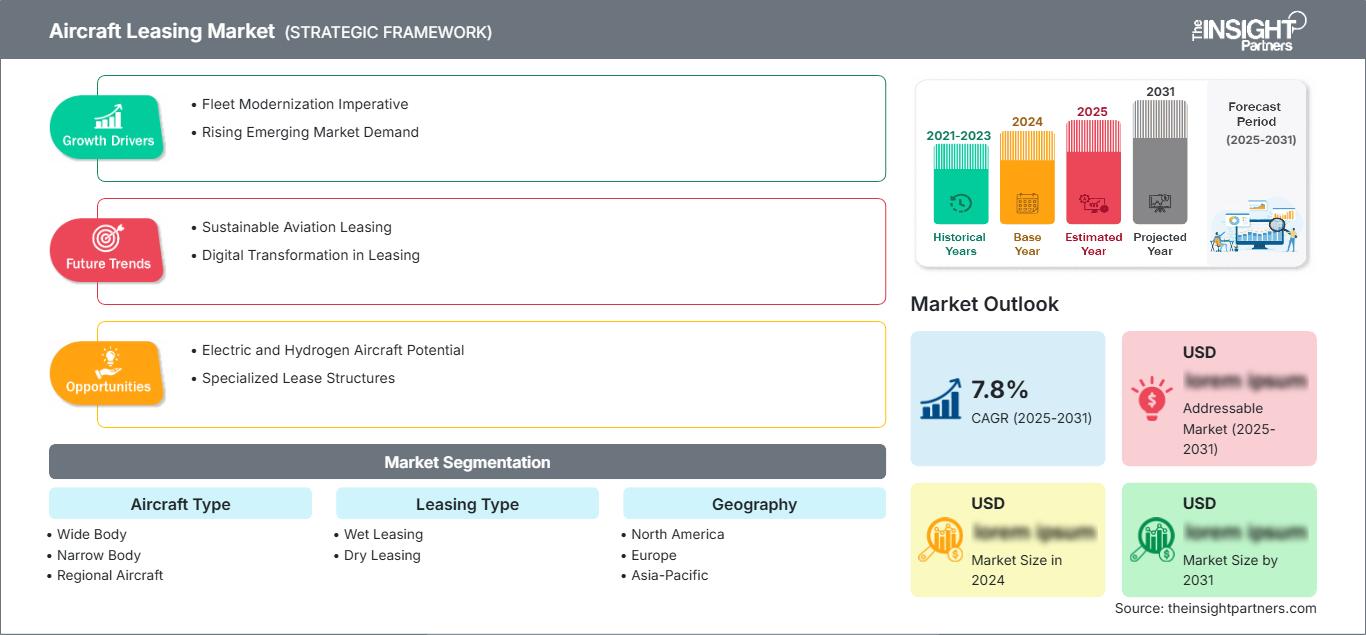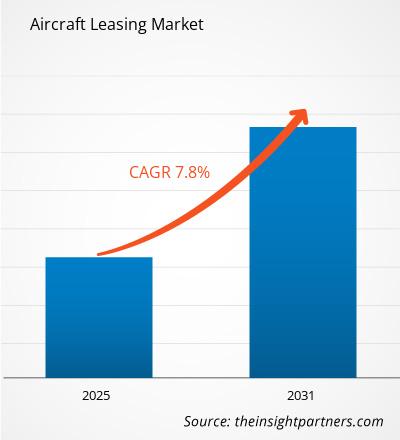Se espera que el tamaño del mercado de arrendamiento de aeronaves alcance los 476.570 millones de dólares estadounidenses para 2031. Se anticipa que el mercado registre una CAGR del 11,1 % durante 2025-2031.
El informe está segmentado por tipo de aeronave (de fuselaje ancho, de fuselaje estrecho, regional) y tipo de arrendamiento (leasing con tripulación, leasing sin tripulación). El análisis global se desglosa a nivel regional y por países principales. El informe ofrece el valor en USD para el análisis y los segmentos mencionados.
Propósito del Informe
El informe "Mercado de Arrendamiento de Aeronaves" de The Insight Partners busca describir el panorama actual y el crecimiento futuro, los principales factores impulsores, los desafíos y las oportunidades. Esto proporcionará información a diversos actores del negocio, como:
- Proveedores/fabricantes de tecnología: Para comprender la dinámica cambiante del mercado y conocer las oportunidades potenciales de crecimiento, lo que les permitirá tomar decisiones estratégicas informadas.
- Inversores: Realizar un análisis exhaustivo de tendencias respecto a la tasa de crecimiento del mercado, las proyecciones financieras del mercado y las oportunidades que existen en toda la cadena de valor.
- Órganos reguladores: Regular las políticas y las actividades policiales en el mercado con el objetivo de minimizar el abuso, preservar la confianza de los inversores y defender la integridad y estabilidad del mercado.
Segmentación del mercado de arrendamiento de aeronaves Tipo de aeronave
- Cuerpo ancho
- Cuerpo estrecho
- Aeronaves regionales
Tipo de arrendamiento
- Arrendamiento húmedo
- Arrendamiento en seco
Recibirá personalización de cualquier informe, sin cargo, incluidas partes de este informe o análisis a nivel de país, paquete de datos de Excel, y además aprovechará grandes ofertas y descuentos para empresas emergentes y universidades.
Mercado de arrendamiento de aeronaves: Perspectivas estratégicas

- Obtenga las principales tendencias clave del mercado de este informe.Esta muestra GRATUITA incluirá análisis de datos, desde tendencias del mercado hasta estimaciones y pronósticos.
Factores que impulsan el crecimiento del mercado de arrendamiento de aeronaves
- Imperativo de Modernización de Flota: Las aerolíneas buscan activamente la renovación de su flota para mejorar la eficiencia operativa, reducir el consumo de combustible y las emisiones de carbono. La creciente presión económica para optimizar el rendimiento de la flota está impulsando un aumento en la actividad de arrendamiento de aeronaves. El arrendamiento ofrece a las aerolíneas la flexibilidad para actualizar rápidamente su tecnología sin grandes inversiones de capital, lo que les permite adaptarse rápidamente a la dinámica cambiante del mercado y a las estrictas regulaciones ambientales.
- Aumento de la demanda en los mercados emergentes: El rápido crecimiento económico en las regiones de Asia-Pacífico y Oriente Medio está impulsando una expansión sin precedentes de la aviación. Los mercados emergentes están experimentando un aumento repentino de la demanda de viajes aéreos, lo que genera una demanda considerable de nuevas aeronaves. Las compañías de leasing ofrecen a estas aerolíneas en crecimiento un acceso rentable a tecnologías de flota modernas, lo que reduce los considerables gastos iniciales de adquisición y permite una entrada acelerada al mercado con menores barreras financieras.
Tendencias futuras del mercado de arrendamiento de aeronaves
- Arrendamiento de Aviación Sostenible: Las consideraciones ambientales están transformando los modelos de arrendamiento de aeronaves. Las compañías de arrendamiento priorizan cada vez más las aeronaves de nueva generación de bajo consumo de combustible y bajas emisiones. Esta tendencia refleja la creciente presión regulatoria y el compromiso de las aerolíneas de reducir la huella de carbono. Las estructuras de arrendamiento avanzadas incorporan ahora métricas de sostenibilidad, lo que incentiva la inversión en plataformas de aeronaves tecnológicamente avanzadas y respetuosas con el medio ambiente.
- Transformación digital en el leasing: La innovación tecnológica está revolucionando el leasing de aeronaves mediante análisis avanzado de datos, mantenimiento predictivo y sofisticadas plataformas de gestión de flotas. Las empresas de leasing están aprovechando la inteligencia artificial, la cadena de bloques y los sistemas de monitorización en tiempo real para optimizar el seguimiento de activos, los programas de mantenimiento y ofrecer soluciones de leasing más transparentes y eficientes. Esta evolución digital está mejorando la gestión de riesgos y creando ecosistemas de leasing más dinámicos.
Oportunidades en el mercado de arrendamiento de aeronaves
- Potencial de las aeronaves eléctricas y de hidrógeno: Las tecnologías emergentes de propulsión eléctrica y de hidrógeno representan una oportunidad transformadora para los mercados de arrendamiento de aeronaves. A medida que avanzan los avances tecnológicos, las empresas de arrendamiento pueden posicionarse a la vanguardia de la innovación en aviación sostenible. Las inversiones tempranas en estas tecnologías aeronáuticas emergentes podrían brindar importantes ventajas competitivas, permitiendo que las carteras de arrendamiento se adapten a los futuros requisitos ambientales y operativos.
- Estructuras de arrendamiento especializadas: Las configuraciones de arrendamiento innovadoras dirigidas a segmentos de mercado específicos presentan importantes oportunidades de crecimiento. Las soluciones de arrendamiento a medida para aerolíneas regionales, operadores de carga y servicios de aviación especializados pueden generar nuevas fuentes de ingresos. Las condiciones de arrendamiento personalizadas que abordan requisitos operativos específicos, como compromisos a corto plazo, cláusulas de mantenimiento flexibles y acuerdos tecnológicos específicos, pueden atraer a aerolíneas de diversos tipos que buscan estrategias de gestión de flotas más adaptables.
Perspectivas regionales del mercado de arrendamiento de aeronaves
Los analistas de The Insight Partners han explicado detalladamente las tendencias regionales y los factores que influyen en el mercado de arrendamiento de aeronaves durante el período de pronóstico. Esta sección también analiza los segmentos y la geografía del mercado de arrendamiento de aeronaves en América del Norte, Europa, Asia Pacífico, Oriente Medio y África, y América del Sur y Central.
Alcance del informe sobre el mercado de arrendamiento de aeronaves
| Atributo del informe | Detalles |
|---|---|
| Tamaño del mercado en 2024 | XX mil millones de dólares estadounidenses |
| Tamaño del mercado en 2031 | US$ 476.57 mil millones |
| CAGR global (2025-2031) | 11,1% |
| Datos históricos | 2021-2023 |
| Período de pronóstico | 2025-2031 |
| Segmentos cubiertos | Por tipo de aeronave
|
| Regiones y países cubiertos | América del norte
|
| Líderes del mercado y perfiles de empresas clave |
|
Densidad de actores del mercado de arrendamiento de aeronaves: comprensión de su impacto en la dinámica empresarial
El mercado de arrendamiento de aeronaves está creciendo rápidamente, impulsado por la creciente demanda de los usuarios finales debido a factores como la evolución de las preferencias de los consumidores, los avances tecnológicos y un mayor conocimiento de los beneficios del producto. A medida que aumenta la demanda, las empresas amplían su oferta, innovan para satisfacer las necesidades de los consumidores y aprovechan las tendencias emergentes, lo que impulsa aún más el crecimiento del mercado.

- Obtenga una descripción general de los principales actores clave del mercado de arrendamiento de aeronaves
Puntos clave de venta
- Cobertura integral: el informe cubre exhaustivamente el análisis de productos, servicios, tipos y usuarios finales del mercado de arrendamiento de aeronaves, proporcionando un panorama holístico.
- Análisis de expertos: el informe se compila con base en el conocimiento profundo de expertos y analistas de la industria.
- Información actualizada: El informe asegura relevancia comercial debido a su cobertura de información reciente y tendencias de datos.
- Opciones de personalización: este informe se puede personalizar para satisfacer los requisitos específicos del cliente y adaptarse adecuadamente a las estrategias comerciales.
Por lo tanto, el informe de investigación sobre el mercado de arrendamiento de aeronaves puede ayudar a descifrar y comprender el panorama de la industria y sus perspectivas de crecimiento. Si bien existen algunas preocupaciones válidas, las ventajas generales de este informe suelen superar las desventajas.
- Análisis histórico (2 años), año base, pronóstico (7 años) con CAGR
- Análisis PEST y FODA
- Tamaño del mercado, valor/volumen: global, regional y nacional
- Industria y panorama competitivo
- Conjunto de datos de Excel
Informes recientes
Testimonios
Razón para comprar
- Toma de decisiones informada
- Comprensión de la dinámica del mercado
- Análisis competitivo
- Información sobre clientes
- Pronósticos del mercado
- Mitigación de riesgos
- Planificación estratégica
- Justificación de la inversión
- Identificación de mercados emergentes
- Mejora de las estrategias de marketing
- Impulso de la eficiencia operativa
- Alineación con las tendencias regulatorias




















 Obtenga una muestra gratuita para - Mercado de arrendamiento de aeronaves
Obtenga una muestra gratuita para - Mercado de arrendamiento de aeronaves